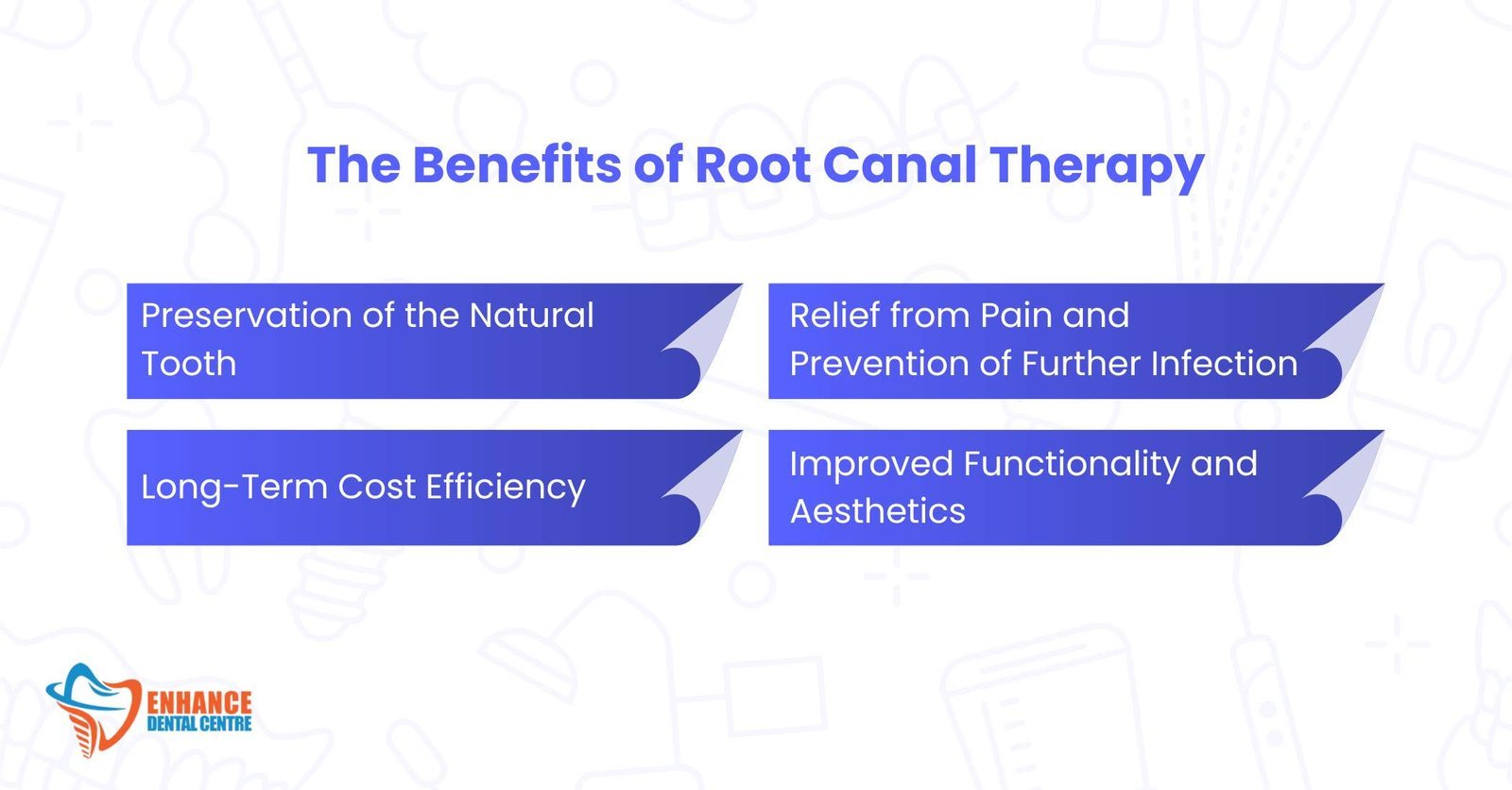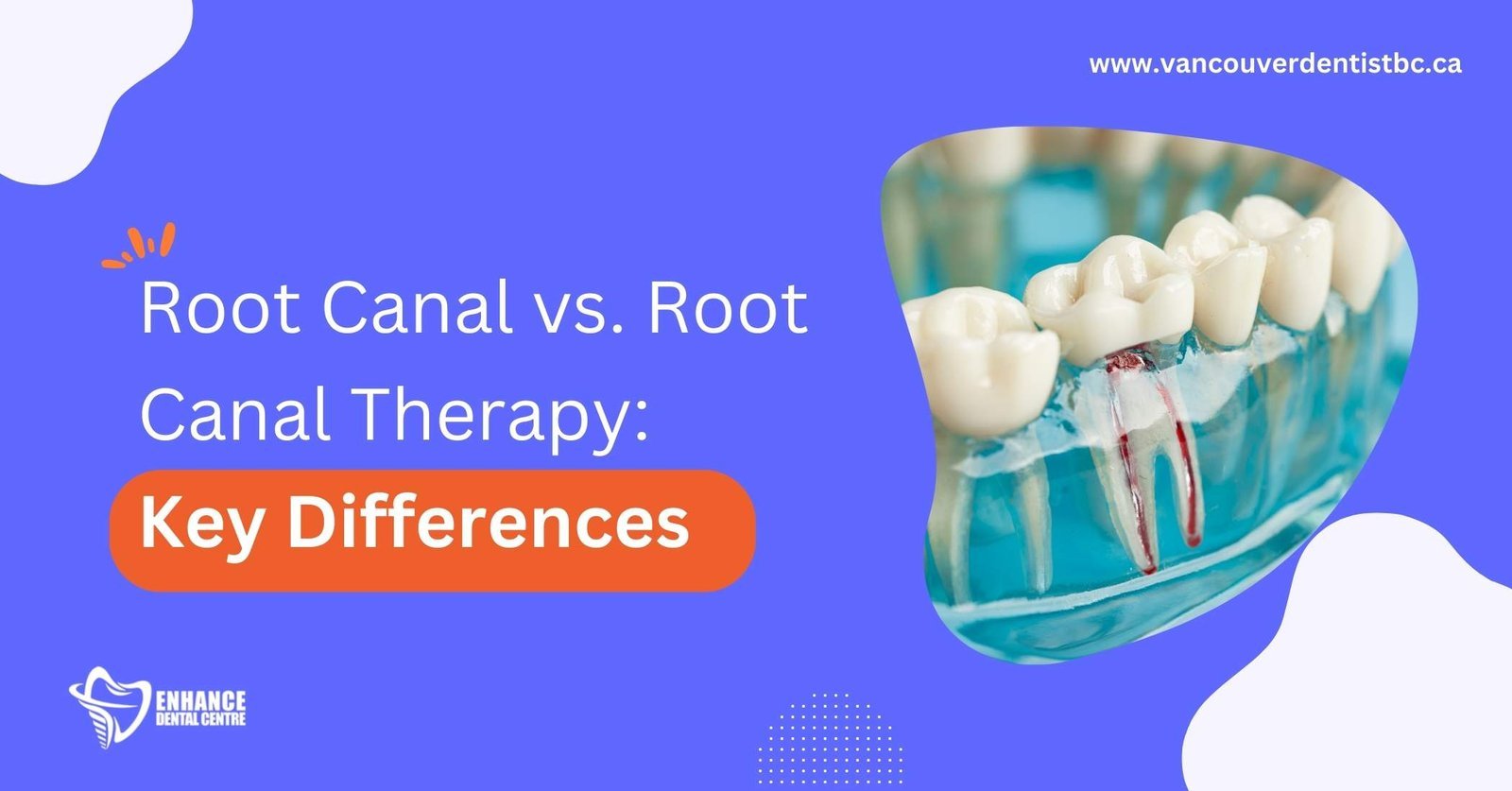Understanding dental procedures is key to making informed decisions about your health. Many patients often confuse the terms “root canal” and “root canal therapy.” Are they the same? What do these terms mean, and how do they impact your dental care?
At Enhance Dental Centre, we understand that dental terminology can be overwhelming. That’s why we’ve created this guide to clearly explain the distinction between a root canal (an anatomical part of a tooth) and root canal therapy (the procedure to treat issues within the root canal).
In this blog, we’ll explore the differences, the steps involved in root canal therapy, when it’s necessary, and how it helps preserve your natural tooth and improve overall dental health. Let’s dive into the world of root canal procedures to support your journey toward a healthier, more confident smile.
Root canal vs. root canal therapy: what’s the difference?
The terms “root canal” and “root canal therapy” are often used interchangeably, but they refer to different aspects of dental care. Understanding this distinction is crucial for making informed decisions about your dental health.

What is a root canal?
A root canal is an anatomical part of your tooth. It refers to the space within the tooth’s root that houses the dental pulp, a soft tissue made up of nerves, blood vessels, and connective tissue.
- Location: Inside the tooth’s root.
- Function: Provides nutrients and sensations during the tooth’s development.
- Once the tooth is fully grown, the pulp is no longer essential, as the surrounding tissues supply what the tooth needs.
What is root canal therapy?
Root canal therapy, also known as endodontic treatment, is a procedure designed to treat problems within the root canal. It becomes necessary when the dental pulp is infected, inflamed, or damaged due to deep decay, cracks, or trauma.
- Purpose: Root canal therapy removes infection, relieves pain, and saves the natural tooth.
- Outcome: Relieves Pain, removes infected tissue and also prevents further complications.
- Procedure: Involves removing the damaged pulp, cleaning the root canal, and sealing it to avoid reinfection.
Key Differences: Root Canal vs. Root Canal Therapy |
||
|---|---|---|
| Aspect | Root Canal | Root Canal Therapy |
| Definition | The Natural Cavity Within the Tooth’s Root Containing Pulp | The Procedure to Treat Issues Within the Root Canal |
| Purpose | Houses Nerves, Blood Vessels, and Pulp During Tooth Development | Removes Infection, Relieves Pain, and Preserves the Natural Tooth |
| Components | Includes Dental Pulp, Nerves, and Blood Vessels | Involves Cleaning, Disinfecting, and Sealing the Root Canal |
| Cause of Concern | Can Become Infected or Inflamed Due to Decay or Trauma | Addresses Damage or Infection Within the Root Canal |
| Performed By | N/A (Anatomical Structure) | Endodontist or General Dentist |
By understanding these differences, you can better navigate your dental care options and address issues with confidence. If you suspect you might need root canal therapy, contact Enhance Dental Centre for expert guidance and personalized treatment.
Anatomy of a Tooth and the Role of the Root Canal
A tooth consists of three main layers:
- Enamel: The hard, protective outer layer.
- Dentin: The middle layer that provides structure and supports the enamel.
- Pulp Chamber and Root Canals: The innermost layer, containing dental pulp made up of nerves, blood vessels, and connective tissue.
The root canals play a crucial role during tooth development by providing nourishment and sensation through the pulp. However, once the tooth is fully grown, it can still function without the pulp as surrounding tissues provide the necessary support.
Common Issues Affecting the Root Canal:
- Tooth Decay: Cavities that penetrate deep enough to reach the pulp.
- Infection: Resulting from untreated cavities or other bacterial intrusions.
- Trauma: Cracks or fractures exposing the pulp to damage or infection.
When these problems arise, root canal therapy becomes essential to remove the damaged or infected pulp, prevent further complications, and preserve the natural tooth without extracting it. By addressing these issues early, you can maintain both your oral health and your smile.
What does root canal therapy involve?
Root canal therapy is a step-by-step procedure designed to treat problems within the root canal while preserving the natural tooth. Before the treatment begins, your dentist or endodontist will conduct a thorough evaluation, which may include:
- X-rays: To assess the extent of damage and confirm the need for a root canal.
- Sensitivity Tests: Gentle tapping, or the application of hot or cold substances, to check for pain or discomfort.
- Electric Pulp Test (EPT): A small electric current to evaluate the vitality of the tooth pulp.
- Swelling and Pain Checks: Examination of the gums and surrounding bone for signs of infection or inflammation, along with questions about pain when biting.
Steps in Root Canal Therapy:
- Anesthesia: The dentist will numb the affected tooth and surrounding gums with a local anesthetic. For anxious patients, medication may be offered to help you relax, but this can cause drowsiness, so driving afterward should be avoided.
- Dental Dam Placement: A thin rubber sheet is placed over the tooth to keep the area dry and free from saliva during the procedure.
- Accessing the Root Canal: A small hole is drilled on top of the tooth to reach the pulp chamber and root canals.
- Removing the Damaged Pulp: Using tiny instruments, the dentist removes the nerves, blood vessels, and tissues inside the tooth.
- Cleaning and Disinfecting: The root canal and pulp chamber are meticulously cleaned and disinfected to eliminate bacteria and prevent further infection.
- Filling and Sealing: The empty canals are filled with a flexible, biocompatible material called gutta-percha. A temporary filling is placed to seal the tooth and protect it from bacteria until a permanent crown is ready.
- Crown Placement: A custom dental crown is placed over the treated tooth to protect it and restore its full function without future breakage. This step may take two to three weeks, depending on the time needed to fabricate the crown. Sometimes a dentist may choose to wait a month or two until the tooth settles to complete the final restoration.
When is root canal therapy necessary?
Root canal therapy becomes essential when the dental pulp inside a tooth is damaged or infected. Addressing these issues promptly can help preserve your natural tooth and prevent further complications. Common reasons for this treatment include:
- Severe Tooth Decay: Deep cavities that reach the pulp and cause infection or inflammation.
- Untreated Cavities: Prolonged decay that spreads, leading to root canal infections.
- Cracked or Fractured Teeth: Breaks in the tooth structure that expose the pulp to bacteria.
- Persistent Sensitivity or Pain: Ongoing discomfort, especially to hot or cold stimuli, often signals pulp damage.
- Abscess Formation: A painful infection at the tooth’s root filled with pus, indicating serious infection.
Ignoring these issues can lead to more severe problems, such as the spread of infection, tooth loss, or the need for more complex and costly treatments later. If you’re experiencing any of these symptoms, consult Enhance Dental Centre for expert advice and timely care.
What are the benefits of root canal therapy?
Root canal therapy offers several critical benefits for your dental health and overall well-being:

Preservation of the Natural Tooth
This procedure removes the infected pulp and seals the root canal, allowing you to keep your natural tooth intact. By avoiding extraction, you maintain your smile’s natural appearance and dental structure.
Relief from Pain and Prevention of Further Infection
Root canal therapy addresses the source of pain caused by inflammation or abscesses. It also eliminates bacteria, preventing the spread of infection to other teeth or surrounding tissues.
Long-Term Cost Efficiency
Compared to tooth extraction and replacements like implants or bridges, root canal therapy is a cost-effective option. Keeping your natural tooth reduces the likelihood of needing additional dental procedures in the future.

Improved Functionality and Aesthetics
With a custom dental crown restoration, your treated tooth functions like a natural tooth. You can chew, speak, and smile confidently while preserving the tooth’s natural appearance.
Root canal therapy not only restores your dental health but also helps you maintain your natural smile and prevent more extensive treatments down the line. To learn more about how this procedure can benefit you, contact Enhance Dental Centre today.
Risks of Avoiding Root Canal Therapy
Delaying or avoiding root canal therapy can lead to serious dental and overall health complications. Addressing dental issues promptly and following preventive dentistry practices can help you maintain a healthy smile and avoid these complications. Here are some of the key risks:
Spread of Infection
Untreated infections in the root canal can spread to surrounding teeth, gums, or even other parts of the body, potentially causing severe health problems such as abscesses or systemic infections.
Tooth Loss
Without timely treatment, the infected tooth may become too damaged to repair, resulting in the need for extraction. Tooth loss can impact your smile, chewing ability, and oral health.
Jawbone Deterioration
Losing a tooth can lead to the gradual weakening of the jawbone in the affected area, compromising the stability of surrounding teeth and potentially altering your facial structure.
More Complex and Expensive Treatments
Delaying care often means more extensive procedures will be required later, such as dental implants, bridges, or dentures, which are typically more invasive and costly than root canal therapy.
By addressing root canal issues promptly, you can avoid these complications and preserve your natural tooth. If you suspect you may need root canal therapy, schedule a consultation with Enhance Dental Centre for expert care.
Post-Treatment Care Tips for Root Canal Therapy
Proper post-treatment care is crucial for a smooth recovery and ensuring long-term dental health after root canal therapy. Follow these key tips to protect your treated tooth and promote healing:
Immediate Post-Treatment Care
Refrain from eating, drinking, or touching the treated tooth with your tongue for at least 30 minutes. This allows the filling to harden properly.

Pain Management
Take any prescribed medications as instructed by your dentist. If none are prescribed, over-the-counter pain relievers like ibuprofen (Motrin, Advil) or acetaminophen (Tylenol) can help. Be sure to follow dosage instructions and contact your dentist if pain persists.
Apply a cold compress to the affected area for 20 minutes at a time, with 20-minute breaks in between, to reduce swelling.
Chewing Precautions
Do not chew on the side of the treated tooth until the permanent crown or restoration is placed, as temporary fillings or crowns can break easily.
Oral Hygiene
Maintain good oral hygiene by gently brushing and flossing around the treated area to keep it clean and prevent further issues.
Temporary Filling Concerns
If the temporary filling comes out, contact your dentist immediately. As a short-term fix, you can use over-the-counter dental filling material to protect the tooth until your appointment.
Managing Discomfort
Some discomfort is expected for 2 to 4 days, and occasionally up to a few weeks. This is a normal part of the healing process.
General Care Instructions
Follow any additional instructions provided by your dentist. Regular brushing, flossing, and medication use as directed are essential for a successful recovery.
By following these care tips, you can ensure a smooth recovery and protect your treated tooth. If you have any concerns or questions about your recovery, contact Enhance Dental Centre for guidance and support.
Technological Advances in Root Canal Therapy
Advancements in dental technology have revolutionized root canal therapy, making the procedure more precise, efficient, and comfortable for patients. At Enhance Dental Centre, we incorporate the latest techniques and equipment and advanced endodontic treatments to ensure the highest quality of care and successful outcomes for our patients.
Digital Imaging for Precision
Modern digital X-rays provide highly detailed images of your teeth, enabling accurate diagnosis and treatment planning. This technology helps us identify problem areas with precision while minimizing radiation exposure.
Rotary Instruments for Efficient Cleaning
State-of-the-art rotary instruments allow us to clean root canals more thoroughly and quickly. These tools not only reduce treatment time but also ensure that all infected tissue is effectively removed, enhancing the overall success of the procedure.
Advanced Materials for Sealing and Restoration
We use biocompatible materials to fill and seal the cleaned root canal, preventing reinfection and restoring the tooth’s strength. These advanced materials ensure a longer-lasting restoration while maintaining the natural function and appearance of your tooth.
By leveraging these technological advancements, Enhance Dental Centre ensures that your root canal therapy is as effective and comfortable as possible. Contact us today to learn more about how we use cutting-edge tools and techniques to deliver exceptional dental care.
Cost Considerations for Root Canal Therapy
The cost of root canal therapy can vary depending on several factors, including:
- Tooth Location: Treating molars is more complex and typically costs more than treating front teeth.
- Severity of Damage: Advanced infections or extensive damage may require additional procedures, increasing the overall cost.
- Restoration Needs: Costs can differ based on whether you need a filling or a custom dental crown after the procedure.
At Enhance Dental Centre, we understand that cost is an important consideration for our patients. Many dental insurance plans cover part or all of the expenses for root canal therapy, depending on the details of your plan. For out-of-pocket costs, we offer flexible financing options to make high-quality care accessible and affordable.
Investing in root canal therapy not only saves your natural tooth but also helps you avoid more expensive treatments, such as implants or bridges, in the future. Contact Enhance Dental Centre today to learn more about our insurance coverage and financing options, and let us help you preserve your smile with expert care.
Conclusion
Understanding the difference between a root canal and root canal therapy is essential for making informed decisions about your dental health. Root canal therapy not only preserves your natural tooth but also alleviates pain and prevents serious complications in the future.
At Enhance Dental Centre, we combine expert care with advanced technology to ensure a comfortable and effective treatment experience. From diagnosis to recovery, our dedicated team is here to support you every step of the way, helping you maintain a healthy, confident smile.
Don’t delay addressing dental issues—early intervention is key to preserving your oral health. Schedule your appointment with Enhance Dental Centre today and explore our comprehensive dental services to maintain a healthy, confident smile. Your journey to a healthier smile begins with us!






